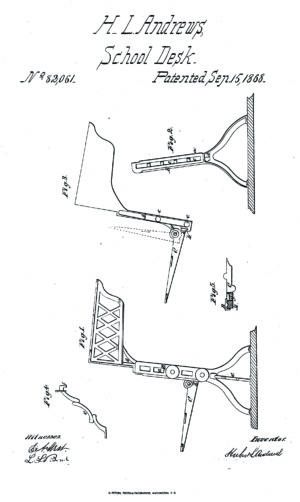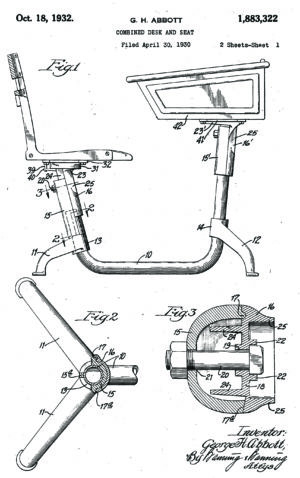New wardrobe has been purchased, school supplies have been stocked, lunch is packed, now it’s time for your first patent history lesson of the new school year– a brief history of school desk patents!
The “Fashion Desk”
Although desks like Herbert L. Andrews’ “SCHOOL DESK” (U.S. Patent No. 82,061) had been patented earlier, John Loughlin, Founder of the Sidney School Furniture Company, is credited as the inventor of one of the first, most popular desks of the 1880s, the “Fashion Desk.”

One innovative feature of Loughlin’s desk was its “T-Head” structure. This assembly allowed many desks to be assembled together, rather than bolted to the floor. Most fashion desks also included a built-in inkwell, allowing students to re-ink their pens without leaving their desk.
Although Loughlin never received a patent for the fashion desk, Anna Breadin received a patent for the desk she modeled after Loughlin’s desk, “SCHOOL DESK,” (U.S. Patent No. 400,738) in 1889. The Sidney School Furniture Company sold and manufactured the model, and it remained popular for many years.

The Welsh Desk
As time went on, wider desks like the Welsh School Desk were made to accommodate the growing number of students in the classroom during the 1920s. These desks could seat two students side-by-side and had double compartment storage allowing students to access their school supplies easily.

The “Adjustable School Desk”
In the 1930s, a desk known as the “Adjustable School Desk” permitted students to make vertical adjustments of the desk and the seat. It also allowed the student to swivel their chair from side-to-side. A patent of this desk was granted to George H. Abbott on April 30, 1930, entitled “COMBINED DESK AND SEAT” (U.S. Patent No. 1,883,322).

The One-Armed Desk
Desks continued to evolve into 1970s. One of the more popular models was the fiberboard, plastic, and chrome wrapped desk, “TABLET ARM FOR WIRE ROD CHAIR,” (U.S. Patent No. 4,159,841). This desk swapped the storage area from the top of the desk to space under the seat for a backpack, leaving a more limited space for students to write, and a headache for left-handed students. Although there was a brief break in this style of desk during the 1980s to a hollowed steel and plywood-topped desk, many schools returned to the 1970s model because of their more affordable price.

Desks for Health and Saftey
As the new millennium approached, newer desks focused on the health and safety of students. For example, “STUDENT EXERCISE DESK” (U.S. Patent No. D637,663), was designed as a stand-alone desk, high enough to allow a student to stand without using a stool or chair. Workplaces encouraged this trend as well, allowing office workers the option to sit or stand during their workweek.
In the wake of increasing tragic events, schools have also tried to put a heavier emphasis on the safety of students. Patents like “DESK AND REMOVABLE BULLET RESISTANT DESKTOP SHIELD” (U.S. Patent No. 6,170,379) aimed to add more safety and security to schools by doubling as protection.

Although desks have changed throughout the years, many traits of the original designs can be found in those created today. Which desks did you sit in when you went to school? Be sure to let us know on our social channels. We’re active on Facebook, Twitter, and Instagram!
